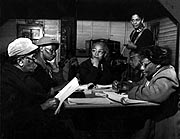|
A
native Charlestonian, she had more recently been fired
from her job as a South Carolina school teacher for
belonging to the NAACP. Along with Esau and the Highlander
staff, she developed an empowering literacy and citizenship
program which would eventually spread throughout the
sea islands and later across the South. Bernice Robinson
was chosen to teach the first citizenship school because
she respected the people and, having had no teaching
experience, would be nonjudgmental and experimental.
Singing familiar songs enlivened the long evenings and
blended with the joy of learning.
|
|

Citizenship
School class, late 1950s
center (l-r): Alice Wine, Septima Clark, Bernice Robinson
Photographer: Ida Berman
|

